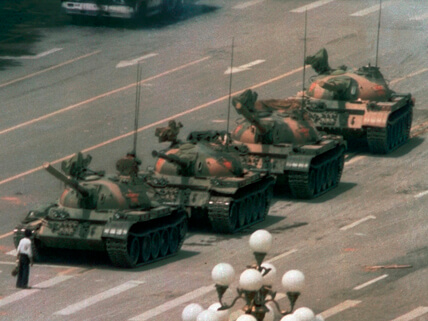Symbolizing freedom and defiance, an anonymous man stands athwart a column of army tanks in the wake of the Tiananmen Square Massacre.
If you lived in China today, you would find it next to impossible to learn anything about the “June Fourth incident.” The basic history of what happened at Tiananmen Square in Beijing, China, in the late spring of 1989 goes like this: 1) students demonstrate for democracy; 2) the Communist Chinese government sends in troops and tanks and brutally massacres the protesters. While this is accurate, there is much more to this pivotal historic event.
The protests began in April 1989, and by May, nearly a million Chinese—mostly young students but also laborers, housewives, doctors, and even Chinese Navy sailors—crowded into central Beijing. With daily vigils, marches, and chants, they called for democratic reforms. Protesters criticized China’s rampant political corruption, as well as widespread environmental pollution and weakening economy. When Deng Xiaoping denounced the demonstrations in the People’s Daily as “rioting” by a “tiny minority,” the protesters were further inflamed. More than 1,000 students launched a hunger strike.
For a brief moment, a papier-mâché likeness of the Statue of Liberty was raised in Tiananmen Square. As Western reporters captured the drama for global TV and newspaper audiences, the protests spread to hundreds of Chinese cities. Then came the brutal crackdown. The leadership of the Chinese Communist Party (CCP) ordered Chinese troops into Tiananmen Square on the night of June 3–4. They fired on the crowds of unarmed protesters. Turmoil ensued as protesters fled or fought back, attacking troops with stones and setting fire to military vehicles. The bloody repression killed an estimated 800 to 4,000 people. Security forces arrested an additional 10,000.
Although the massacre stained the CCP’s legitimacy, its grip on power tightened. In response to the brutal violation of human rights, the U.S. Congress imposed economic sanctions on China. But the policy of “engagement” pursued by Western nations, based on the expectation that market reforms would lead to social and political liberalization, largely failed. In the aftermath of Tiananmen Square, China’s leaders engineered a huge economic expansion, while creating the world’s largest surveillance state. One positive legacy of the demonstrations in Beijing in June 1989 was their influence on protests in Eastern Europe that led to the downfall of communism and the eventual collapse of the Soviet Union. Although a struggle for political reform and human rights still exists in Hong Kong, there is no statue or monument in Tiananmen Square.
Image credit © Jeff Widener/AP Images
Related Links:
- The Tiananmen Square Massacre, 1989: What Really Happened at Tiananmen?
This article provides a thorough examination of the background to the brutal massacre.
(Source: Thoughtco.com, January 29, 2019) - How the Tiananmen Square Massacre Changed China Forever
This article looks at the legacy of the crackdown—the changes it wrought.
(Source: Time, June 4, 2019) - Chinese Crackdown on Protests Leads to Tiananmen Square Massacre
Brief account of the historic repression that ended a prodemocracy movement in China.
(Source: History.com, June 3, 2019) - Tiananmen Square Protests
Photo gallery of the 1989 demonstrations in Beijing’s Tiananmen Square and the subsequent massacre.
(Source: National Review; accessed June 4, 2019) - “The Tank Man”
Full-length Frontline program focused on the iconic Chinese protester at Tiananmen Square, aired originally in 2006.
(Source: PBS Frontline, April 11, 2006)




